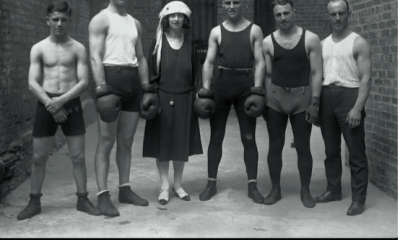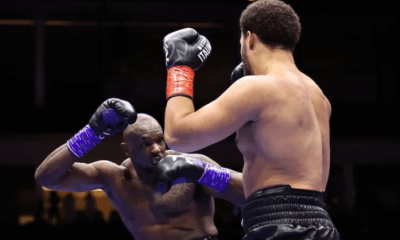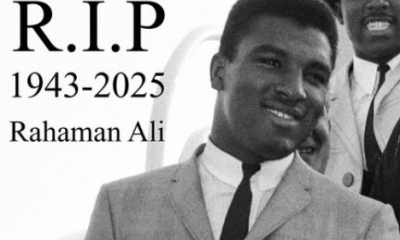Articles of 2005
Victor McLaglan: Boxer, Actor, Soldier, Cop
Many professional boxers over the years have also tried their hand at acting. In recent times we’re reminded of Shannon Briggs playing a villain in “Bad Boys 2” alongside Will Smith, who himself showed some boxing skill in his portrayal of The Greatest in “Ali.” Former heavyweight world champion Lennox Lewis has been quoted saying that he would like get into features as well, having got a taste of it in “Oceans 11.” The list of boxer turned actors is a long one featuring the likes of Frank Bruno, Jake La Motta, Kallie Knoetze and Joe Bugner to name a few; but the one who was the most successful is a man who shared the ring with Jack Johnson and won an Academy Award.
In 1935 former heavyweight boxer Victor McLaglan won Hollywood’s highest accolade as Best Actor with his portrayal of a slowwitted Irishman in director John Ford’s “The Informer.” His fellow nominees were screen legends Clark Gable and Charles Loughton, as well as the lesser known Franchot Tone, who all appeared in the original film version of “Mutiny on the Bounty.”
Up until that year there was no best supporting actor category. That victory made McLaglan box-office and he starred in many memorable films until his death in Hollywood at the age of 72 in 1959. He also garnered a best supporting actor Oscar nomination for the 1952 John Wayne film “The Quiet Man.” This romantic comedy features one of the longest fight scenes in motion picture history as McLaglan and Wayne knock each other about all over the Irish countryside, even stopping to share a pint of beer in mid-fight.
While McLaglan was born in Tunbridge Wells, Kent, in the UK in 1886, he spent his childhood in Cape Town, where his father was the Bishop of Claremont. In an interview with journalist Nora Laing in 1935, McLaglan stated that both his parents were South Africans and that he was first introduced to boxing while playing with his friends in Mouille Point, Cape Town. He referred to his South African roots throughout his career, and up until he became an American citizen in 1933, he would refer to himself as a South African.
Before he became an actor, McLaglan was a formidable boxer. He was, incidentally, the same size and weight as Muhammad Ali 60 years later. In 1909 he was deemed good enough to take on the heavyweight champion of the world Jack Johnson in a six-round exhibition match in Canada. Later the same year he also took on former heavyweight world champion Bob Fitzsimmons in an exhibition staged in Australia. And in 1911 he squared-off in yet another exhibition against Jack Johnson conqueror Jess Willard.
Besides being a professional boxer, McLaglan was also a wrestler and for a time tried his hand at prospecting in Canada. He then worked as a policeman in Winnipeg before joining a circus as a strongman. Between 1909 and 1914 he traveled the world with the circus and took on all comers. Anyone who could go three rounds with the big-hitting McLaglan was paid $25. He enlisted in the army at the start of “The Great War” and in 1918 won the heavyweight championship of the British army.
In 1924 McLaglan retired from boxing with an official record of 19 fights, 11 wins with 9 knockouts, 6 losses and 1 draw and headed for Hollywood where he quickly established himself as a screen presence. He returned to South Africa in 1938 to play the lead opposite Gracie Fields in a film titled “He Was Her Man,” later re-titled “We’re Going to Be Rich.” The film was about the pioneering days in Johannesburg and the highlight was a bareknuckle fight between him and former South African heavyweight and world title contender Don McCorkindale. Interviewed on the set, McLaglan expressed a strong desire to return to his “hometown, Cape Town,” but because of his many commitments he never did.
* * *
In South African boxing news, WBC intercontinental super bantamweight champion Gabula Vabaza 21-0-1 (15) won a lopsided ten-round decision over Filipino veteran Jess Maca 43-21-6 (17) on Friday night. The fight turned out to be more of an exhibition match as Vabaza peppered his opponent with well placed right jabs throughout and moved fluidly around the ring avoiding Maca’s blows. Maca is not known as a puncher, so one can only assume Vabaza adopted this strategy in order to have a bit of a workout.
-

 Featured Articles4 weeks ago
Featured Articles4 weeks agoThe Hauser Report: Zayas-Garcia, Pacquiao, Usyk, and the NYSAC
-

 Featured Articles3 weeks ago
Featured Articles3 weeks agoOscar Duarte and Regis Prograis Prevail on an Action-Packed Fight Card in Chicago
-

 Featured Articles3 weeks ago
Featured Articles3 weeks agoThe Hauser Report: Cinematic and Literary Notes
-

 Book Review2 weeks ago
Book Review2 weeks agoMark Kriegel’s New Book About Mike Tyson is a Must-Read
-

 Featured Articles4 days ago
Featured Articles4 days agoThe Hauser Report: Debunking Two Myths and Other Notes
-

 Featured Articles4 weeks ago
Featured Articles4 weeks agoRemembering Dwight Muhammad Qawi (1953-2025) and his Triumphant Return to Prison
-

 Featured Articles1 week ago
Featured Articles1 week agoMoses Itauma Continues his Rapid Rise; Steamrolls Dillian Whyte in Riyadh
-

 Featured Articles3 weeks ago
Featured Articles3 weeks agoRahaman Ali (1943-2025)















